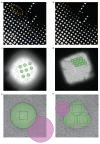Collection, pre-processing and on-the-fly analysis of data for high-resolution, single-particle cryo-electron microscopy
- PMID: 30487656
- PMCID: PMC7618007
- DOI: 10.1038/s41596-018-0084-8
Collection, pre-processing and on-the-fly analysis of data for high-resolution, single-particle cryo-electron microscopy
Abstract
The dramatic growth in the use of cryo-electron microscopy (cryo-EM) to generate high-resolution structures of macromolecular complexes has changed the landscape of structural biology. The majority of structures deposited in the Electron Microscopy Data Bank (EMDB) at higher than 4-Å resolution were collected on Titan Krios microscopes. Although the pipeline for single-particle data collection is becoming routine, there is much variation in how sessions are set up. Furthermore, when collection is under way, there are a range of approaches for efficiently moving and pre-processing these data. Here, we present a standard operating procedure for single-particle data collection with Thermo Fisher Scientific EPU software, using the two most common direct electron detectors (the Thermo Fisher Scientific Falcon 3 (F3EC) and the Gatan K2), as well as a strategy for structuring these data to enable efficient pre-processing and on-the-fly monitoring of data collection. This protocol takes 3-6 h to set up a typical automated data collection session.
Conflict of interest statement
The authors declare no competing interests.
Figures




References
Publication types
MeSH terms
Substances
Grants and funding
LinkOut - more resources
Full Text Sources
Medical
Molecular Biology Databases

